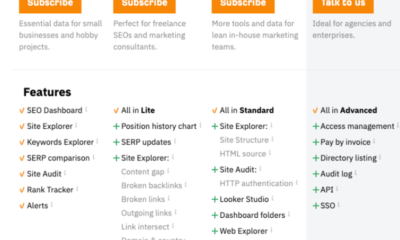Politics
5 Ways to Leverage LinkedIn to Grow Your Business
Published
1 year agoon
By
Drew Simpson
LinkedIn is one of the most effective social media platforms for helping to increase business revenues.
The platform is a hub for professionals to connect and grow their businesses, and it has become even more popular since the Microsoft acquisition. There are 830 million members in over 200 countries, and statistics show that upwards of 40 percent of those members are active on the site daily.
From my personal experience, LinkedIn was an integral part of launching my agency. I gathered a substantial audience by connecting with entrepreneurs and marketing professionals on LinkedIn. When I announced the launch of my agency, many of those same people became the agency’s first clients.
5 strategies entrepreneurs can use to accelerate their business numbers through LinkedIn.
- Leveraging LinkedIn to Grow Business
1. Profile Design
Whether you’re on a casual social media platform like TikTok or professional social media like LinkedIn, the most important thing is to ensure your profile looks as natural and “human” as possible.
It’s important to remember that there are plenty of bot accounts and spammers on LinkedIn. This means that it’s critically important for you to differentiate yourself from those accounts.
First, make sure your profile is complete. Take a recognizable, memorable profile photo and a polished, eye-catching cover photo. It’s also possible to include subtle branding in the cover photo, but less is more here.
Remember to take full advantage of the “featured” section as well. The featured section lets you decide which content is most visible and easily accessible to your users so they can get to know you quickly. It also allows you to highlight helpful information to help your audience learn more about what you do in an immersive, interesting way.
Second, I recommend using the cover story feature to record a brief video introduction. Adding movement to your profile picture produces an instant “wow effect” on people. Anytime we add a cover story to our clients’ profiles, we see an immediate uptick in views and engagement.
You can also use the audio clip feature to make your profile livelier. Initially, the audio clip function was intended to help users know how to pronounce a person’s name, but it can now be used as a brief, humanizing introduction.
Finally, personalize your URL. This is a quick and easy way to make it easier for visitors to remember how to find your page. Keep the URL as simple and relevant as possible.
2. Personal Messaging
Building your brand is not only about regular content and creating an expert image. It is also about communicating with your target audience.
Our agency’s experience proves that the best way to find new clients on LinkedIn is through personal messaging, so it’s recommended to make a goal of sending a certain number of personalized direct messages each week.
Conventional wisdom in most cases is that you shouldn’t immediately message someone with a sales pitch. In my experience, however, a direct approach works best in most markets.
When using LinkedIn messaging, it’s better to get directly to the point. LinkedIn’s audience is typically not inclined to spend time on small talk. Out of consideration for their time, it’s usually best to remember that LinkedIn is first and foremost a business network.
This means that people understand why you’re there (it’s the same reason they are – to conduct business), so you can both go into the relationship understanding that this is a potential business opportunity.
People appreciate that we don’t waste time with meaningless “fluff” messages. They know that something will be sold to them by the end of the conversation, so they prefer to jump straight into the sales portion and skip the time-wasting messages. We’ve learned from practice that the longer the conversation, the faster a new connection stops responding to messages.
3. Follow-ups
Research has proven that the average response to a LinkedIn message is three times higher than traditional email! However, that doesn’t guarantee a response. The most common reaction to a message (especially one with no real substance) is to ignore it.
This doesn’t necessarily mean that the person on the other end isn’t interested in your proposal. Instead, they are so inundated with notifications, tasks, messages and posts on LinkedIn that it’s easy for your message to get lost in the shuffle or put off “until later.”
Sending a follow-up is a positive thing, and many connections appreciate it. Follow-ups are essential because they act as gentle reminders and show the person that you are still interested in speaking to them. This takes the pressure off the person by giving them the ability to respond to a new message with additional information.
A follow-up can include audio, video or skill enforcement, or it can simply be an invitation to chat with an emoji or gif. Don’t be afraid to get creative! Sometimes, you can follow up with new ideas for the business. How you follow up will depend on your goals, but this is critical to getting more leads.
To maximize your chances of successfully connecting, make a schedule or spreadsheet to track who you’ve messaged and when you need to follow up.
4. Content
The content you create and share greatly affects how effectively you can capture your audience’s attention.
Some aspects of social selling no longer work, so staying on top of trends is essential. For instance, overloading your audience with “walls of text” is a big turn-off. In fact, it’s more difficult to hold someone’s interest with text-only content now.
Shorter posts that share expertise in a personable manner are typically best. If you share a long article, it’s vital to structure it in clear, concise sections that are easily scannable.
Video content offers 1.5-2 times higher engagement levels, so this is where we recommend clients focus their efforts. People enjoy seeing a live person in their feeds, especially if they contain a relatable element of storytelling and memorable, real-life examples. For some clients, we compose short videos with subtitles. Research shows that 92 percent of people watch social media videos with sound off on mobile, so captions and subtitles help you reach more people. Showing you’re a real person (not a bot or spammer) is valuable and emphasizes your expertise.
I’ve spent time analyzing my agency’s project reports across varied industries (e.g., finance, retail, telecom, IT), and I’ve noticed patterns in which types of content generate consistently high response rates:
- Tasteful humor.
- Educational, expert content.
- “How-to” checklists or guides.
- Personal, lifestyle posts.
- Situational agendas (these attract journalists).
In contrast, certain content always has little-to-no engagement:
- Posts with long, abstract intros.
- Posts that reference previous posts. (It’s difficult to follow the thread; each post should be independent.)
- Jargon-filled content.
- Shares without meaningful comments. (The aesthetic is a turn-off.
5. LinkedIn Events
On LinkedIn, you can schedule events and quickly invite your connections. Currently, the platform allows you to send out up to 1,000 invitations every week, giving you many opportunities to build your network and generate leads.
The event could be anything from a small webinar or livestream to a larger conference. Your event’s type and size will depend on your specific goal for that interaction.
Organizing live online events is a big trust booster because it shows that you are legitimate and serious about sharing your knowledge with others.
For example, ModumUp recently organized a conference. We sent connection requests to people who we believed were most likely to find the conference relevant to their current business objectives. The conference was our means of quickly building trust with these new connections, and it gave us a solid launch point from which we could send personalized messages with ideas most relevant to their needs.
So, the step-by-step flow would look like this:
- Organize the event on your end.
- Invite your target audience.
- Use the event to build trust and rapport rapidly.
- Send follow-ups with additional materials.
- Ensure your product or service is relevant for invitees.
LinkedIn is a Valuable Business Resource When Used Correctly
Facebook, Twitter, YouTube and Instagram all play important roles in creating a strong online presence for your personal brand. However, the business-first focus of LinkedIn makes it uniquely valuable for anyone who is growing their business.
Remember to put a human face on your profile, and ensure you’re fully showcasing your expertise. Leverage the platform’s private messaging and event capabilities to build strong connections and generate a consistent stream of new leads.
LinkedIn offers even more functions, but, in my agency’s experience, the features listed here are the best for connecting with people and growing your business.
Inner Image Credit and Featured Image Credit: Photo by Mikhail Nilov; Pexels; Thank you!
Olga Bondareva
I’m a Social Seller, business owner, ex-Microsoft Social Media Lead in CEE, and mother of my lovely daughter 😊
My team and I help B2B companies accelerate their social media presence and generate leads and sales on social media.
If I can help your company build your key experts’ or top managers’ personal brands on social media and generate leads, please contact me via email or LinkedIn: olga@modumup.com
You may like
-


Four ways AI is making the power grid faster and more resilient
-


Plastic is a climate change problem. There are ways to fix it.
-


Using Augmented Reality to Level up your E-Commerce Business
-


15 Proven Ways to Increase Customer Engagement and Build Loyalty
-


Data analytics reveal real business value
-


Four Clever Ways to Use Tiered Pricing for Maximum Profit
Politics
Fintech Kennek raises $12.5M seed round to digitize lending
Published
6 months agoon
10/11/2023By
Drew Simpson
London-based fintech startup Kennek has raised $12.5 million in seed funding to expand its lending operating system.
According to an Oct. 10 tech.eu report, the round was led by HV Capital and included participation from Dutch Founders Fund, AlbionVC, FFVC, Plug & Play Ventures, and Syndicate One. Kennek offers software-as-a-service tools to help non-bank lenders streamline their operations using open banking, open finance, and payments.
The platform aims to automate time-consuming manual tasks and consolidate fragmented data to simplify lending. Xavier De Pauw, founder of Kennek said:
“Until kennek, lenders had to devote countless hours to menial operational tasks and deal with jumbled and hard-coded data – which makes every other part of lending a headache. As former lenders ourselves, we lived and breathed these frustrations, and built kennek to make them a thing of the past.”
The company said the latest funding round was oversubscribed and closed quickly despite the challenging fundraising environment. The new capital will be used to expand Kennek’s engineering team and strengthen its market position in the UK while exploring expansion into other European markets. Barbod Namini, Partner at lead investor HV Capital, commented on the investment:
“Kennek has developed an ambitious and genuinely unique proposition which we think can be the foundation of the entire alternative lending space. […] It is a complicated market and a solution that brings together all information and stakeholders onto a single platform is highly compelling for both lenders & the ecosystem as a whole.”
The fintech lending space has grown rapidly in recent years, but many lenders still rely on legacy systems and manual processes that limit efficiency and scalability. Kennek aims to leverage open banking and data integration to provide lenders with a more streamlined, automated lending experience.
The seed funding will allow the London-based startup to continue developing its platform and expanding its team to meet demand from non-bank lenders looking to digitize operations. Kennek’s focus on the UK and Europe also comes amid rising adoption of open banking and open finance in the regions.
Featured Image Credit: Photo from Kennek.io; Thank you!
Radek Zielinski
Radek Zielinski is an experienced technology and financial journalist with a passion for cybersecurity and futurology.
Politics
Fortune 500’s race for generative AI breakthroughs
Published
6 months agoon
10/11/2023By
Drew Simpson
As excitement around generative AI grows, Fortune 500 companies, including Goldman Sachs, are carefully examining the possible applications of this technology. A recent survey of U.S. executives indicated that 60% believe generative AI will substantially impact their businesses in the long term. However, they anticipate a one to two-year timeframe before implementing their initial solutions. This optimism stems from the potential of generative AI to revolutionize various aspects of businesses, from enhancing customer experiences to optimizing internal processes. In the short term, companies will likely focus on pilot projects and experimentation, gradually integrating generative AI into their operations as they witness its positive influence on efficiency and profitability.
Goldman Sachs’ Cautious Approach to Implementing Generative AI
In a recent interview, Goldman Sachs CIO Marco Argenti revealed that the firm has not yet implemented any generative AI use cases. Instead, the company focuses on experimentation and setting high standards before adopting the technology. Argenti recognized the desire for outcomes in areas like developer and operational efficiency but emphasized ensuring precision before putting experimental AI use cases into production.
According to Argenti, striking the right balance between driving innovation and maintaining accuracy is crucial for successfully integrating generative AI within the firm. Goldman Sachs intends to continue exploring this emerging technology’s potential benefits and applications while diligently assessing risks to ensure it meets the company’s stringent quality standards.
One possible application for Goldman Sachs is in software development, where the company has observed a 20-40% productivity increase during its trials. The goal is for 1,000 developers to utilize generative AI tools by year’s end. However, Argenti emphasized that a well-defined expectation of return on investment is necessary before fully integrating generative AI into production.
To achieve this, the company plans to implement a systematic and strategic approach to adopting generative AI, ensuring that it complements and enhances the skills of its developers. Additionally, Goldman Sachs intends to evaluate the long-term impact of generative AI on their software development processes and the overall quality of the applications being developed.
Goldman Sachs’ approach to AI implementation goes beyond merely executing models. The firm has created a platform encompassing technical, legal, and compliance assessments to filter out improper content and keep track of all interactions. This comprehensive system ensures seamless integration of artificial intelligence in operations while adhering to regulatory standards and maintaining client confidentiality. Moreover, the platform continuously improves and adapts its algorithms, allowing Goldman Sachs to stay at the forefront of technology and offer its clients the most efficient and secure services.
Featured Image Credit: Photo by Google DeepMind; Pexels; Thank you!
Deanna Ritchie
Managing Editor at ReadWrite
Deanna is the Managing Editor at ReadWrite. Previously she worked as the Editor in Chief for Startup Grind and has over 20+ years of experience in content management and content development.
Politics
UK seizes web3 opportunity simplifying crypto regulations
Published
6 months agoon
10/10/2023By
Drew Simpson
As Web3 companies increasingly consider leaving the United States due to regulatory ambiguity, the United Kingdom must simplify its cryptocurrency regulations to attract these businesses. The conservative think tank Policy Exchange recently released a report detailing ten suggestions for improving Web3 regulation in the country. Among the recommendations are reducing liability for token holders in decentralized autonomous organizations (DAOs) and encouraging the Financial Conduct Authority (FCA) to adopt alternative Know Your Customer (KYC) methodologies, such as digital identities and blockchain analytics tools. These suggestions aim to position the UK as a hub for Web3 innovation and attract blockchain-based businesses looking for a more conducive regulatory environment.
Streamlining Cryptocurrency Regulations for Innovation
To make it easier for emerging Web3 companies to navigate existing legal frameworks and contribute to the UK’s digital economy growth, the government must streamline cryptocurrency regulations and adopt forward-looking approaches. By making the regulatory landscape clear and straightforward, the UK can create an environment that fosters innovation, growth, and competitiveness in the global fintech industry.
The Policy Exchange report also recommends not weakening self-hosted wallets or treating proof-of-stake (PoS) services as financial services. This approach aims to protect the fundamental principles of decentralization and user autonomy while strongly emphasizing security and regulatory compliance. By doing so, the UK can nurture an environment that encourages innovation and the continued growth of blockchain technology.
Despite recent strict measures by UK authorities, such as His Majesty’s Treasury and the FCA, toward the digital assets sector, the proposed changes in the Policy Exchange report strive to make the UK a more attractive location for Web3 enterprises. By adopting these suggestions, the UK can demonstrate its commitment to fostering innovation in the rapidly evolving blockchain and cryptocurrency industries while ensuring a robust and transparent regulatory environment.
The ongoing uncertainty surrounding cryptocurrency regulations in various countries has prompted Web3 companies to explore alternative jurisdictions with more precise legal frameworks. As the United States grapples with regulatory ambiguity, the United Kingdom can position itself as a hub for Web3 innovation by simplifying and streamlining its cryptocurrency regulations.
Featured Image Credit: Photo by Jonathan Borba; Pexels; Thank you!
Deanna Ritchie
Managing Editor at ReadWrite
Deanna is the Managing Editor at ReadWrite. Previously she worked as the Editor in Chief for Startup Grind and has over 20+ years of experience in content management and content development.
